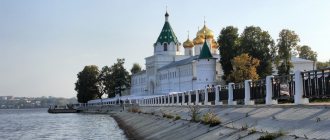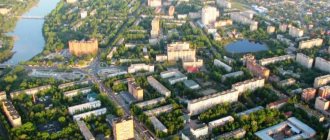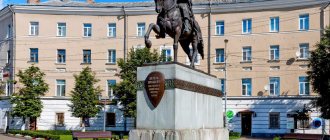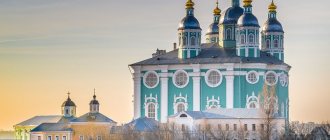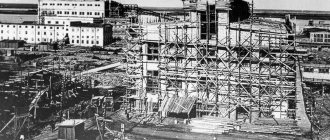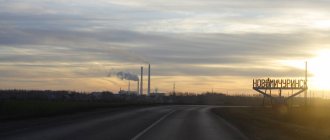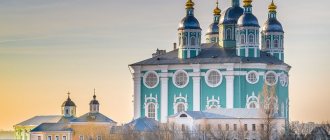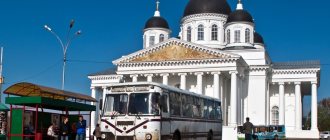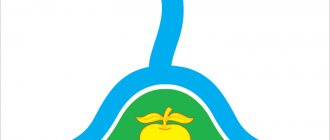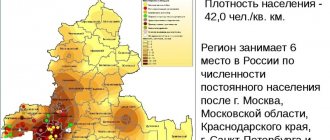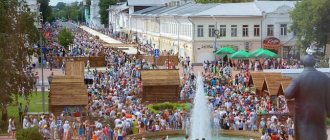The Kostroma region belongs to the Central Federal District. The population here, according to data for 2022, is 637 thousand people, with negative growth observed. The population density is approximately 10.6 people per 1 m². According to 2022 data, almost 73% of the population belongs to urban areas. In terms of national composition, there is the greatest diversity in this part of Russia: a total of 114 nationalities are represented. However, most of all in the territory of this subject of the Russian Federation there are Russians - 97%.
The population can be presented as a list according to the criterion of ability to work (by age). The picture turns out to be alarming:
- The working population is 60%.
- Younger than able-bodied – about 16%.
- Older - approximately 25%.
General information and history of Kostroma
Most people associate the city of Kostroma with ancient Russian history and folklore. The city owes mass propaganda to the group “Ivan Kupala”, whose hit “Great, Kostroma!” firmly ingrained in the subconscious of Russians. Kostroma cheese, Ivan Susanin and the Volga River, on which this ancient city stands, also come to mind.
Kostroma. Bridge over the Volga
Kostroma’s age is truly respectable, it is only 5 years younger than Moscow, and the founder is the same. The city was founded by Prince Yuri Dolgoruky in the middle of the 12th century (1152), during his expansion into the Volga region. This is what historians think, based on chronicle data. It was a fortress city located at the confluence of the Kostroma River into the Volga, and was of great strategic importance in the internecine wars of the Russian princes.
In the middle of the 14th century, the Principality of Moscow, rapidly expanding thanks to the efforts of Ivan Kalita, included Kostroma. The fortified city serves the Moscow princes as reliable protection from attacks by the Tatars and neighboring troops laying claim to the Moscow throne. At the same time, in order to strengthen the city, the Ipatiev Monastery appeared at the mouth of the Kostroma River. Subsequently, it will become the family nest of the Romanov dynasty, and a visit to Kostroma will be included in the mandatory program of every new anointed person from the reigning family.
Holy Trinity Ipatiev Monastery
The history of the Ipatiev Monastery as a family shrine of the Romanov dynasty originates in the events of the Time of Troubles. In 1613, the 16-year-old heir Mikhail Fedorovich, elected to the kingdom, hid behind the strong walls of the monastery from armed detachments of Polish interventionists.
Having the task of destroying the pretender to the throne, the Poles found themselves dangerously close to the hiding place. Their guide to the location of the heir was the local peasant Ivan Susanin, who led the detachment into an impassable swamp, for which he was killed by the Poles. However, the entire detachment died in the swamp, and the future heir was saved. With his coronation, the great Romanov dynasty began its reign, during the 300 years of whose reign the Russian Empire reached unprecedented prosperity.
This feat of a simple Russian peasant was included in all history textbooks, was immortalized in M. Glinka’s opera “A Life for the Tsar” and was officially recognized as a model of valor and patriotism of the Russian people.
Since the beginning of the 17th century, there has been rapid economic growth of the city, and by the end of the 18th century, Kostroma was one of the five largest cities in Russia. Crafts are actively developing, which later became the hallmark of Kostroma: jewelry making, textile production, icon painting, construction.
Kostroma merchants and industrialists created a powerful economic foundation in the city, contributing to its further development and growth in the well-being of the townspeople.
In 1767, Empress Catherine II stopped in Kostroma while on a cruise along the Volga. She was amazed by the beauty of the city and the warmth of the reception. As a token of gratitude, Catherine II granted Kostroma a coat of arms depicting a boat, which to this day is the symbol of the city.
Catherine II is also credited with the idea of developing Kostroma: when asked what a city damaged by a fire should look like, the Empress threw her fan on the table. This layout of the city has been preserved to this day. The center of Kostroma is Susaninskaya Square, from which 7 main radial streets depart, forming a semi-ring open to the Volga, similar to a fan.
Fire tower on Susaninskaya Square. Photo by alexspam007 (https://fotki.yandex.ru/users/alexspam007/)
Today the city of Kostroma is a regional center with a population of 273 thousand people, located 330 km northeast of Moscow. Of course, the former historical and political power was noticeably lost. But the color and regularity of the merchant city remains, which attracts tourists and those who want to find a calm and safe place away from the bustle of big cities.
Hymn
I glorify my city along the Volga River, White temples, your domes. My Kostroma has conquered the world with its beauty, protected by God.
Chorus:
The bells are ringing over Kostroma, Live for centuries, my beloved city, The sweet chime floats over the Volga, I send you, my land, a bow.
Here the sons of heroic strength saved the Fatherland in the hard years, defended my capital with peace, you gave Russia a sovereign.
You conquered the world with the blue Volga, How beautiful, wise and gentle you are, And you decorate the “Golden Ring of Russia”, my Kostroma.
Words by V. Vinogradova.
Climate and ecology of Kostroma
The climatic conditions in Kostroma are a classic example of the Central Russian region. Summer begins at the end of May and lasts until August. The average temperature is +22°. However, in the last 3 years the climate has warmed noticeably, and increasingly in the summer many northern residents feel hot here. Sometimes the temperature stays above +30° for weeks, exhausting the morally and physically unprepared organisms of Kostroma residents.
Winter is traditionally cold, with a lot of snow, which covers the courtyards and main streets of the city with high snowdrifts, annually defeating the housing and communal services service in an unequal struggle. Winter lasts from mid-November to mid-March with an average temperature of -10°. However, there are frosts, and how could we live without them? The thermometer drops from -25 to -30° regularly. High humidity from the Volga aggravates the problem, but Kostroma residents are still more accustomed to frost.
Winter. Arbor A.N. Ostrovsky
From an environmental point of view, Kostroma can be called a prosperous place, of which there are few left. The Kostroma region is recognized as one of the 10 most environmentally friendly zones in Russia. However, this can hardly be attributed to the merits of the local authorities. Rather, this is the result of the degradation of post-Soviet industry. Plus a huge natural reserve in the form of forests (which have not yet been squandered), a system of small rivers and lakes covering the entire territory of the region.
Kostroma forests
On the territory of Kostroma, in addition to the thermal power plants familiar to every city, the main source of pollution is the Fanplit plywood mill. Most of the remaining industrial enterprises and factories have safely ceased to exist and have long been leased out.
The Volga River bears the main blow to the city’s ecology, regularly receiving a “dose” in the form of wastewater. But this little detail can be neglected, given that in Kostroma the Volga is already pumped to the brim with waste from the production of Yaroslavl located upstream.
The conclusion from this is simple: anyone who cares about their health should not swim in the Volga, despite the presence of 2 city beaches and rosy reports from the city SES.
Ostrovsky Drama Theater
The theater was built back in 19
century. Until this time, the city's theater troupes performed in cultural centers and other buildings. The first performance in the theater was based on Ostrovsky's play. His plays are most often staged on the stage of the Kostroma Theater. Most of the performances staged in this theater were successfully received in Moscow and St. Petersburg; they won prestigious competitions, awards and festivals more than once.
Population of Kostroma
According to the regional Civil Registry Office, in 2011 Kostroma managed to reverse the nationwide trend of population decline. For the first time in the last 20 years, the birth rate exceeded the death rate. And this is very noticeable from the outside: there is an incredible number of pregnant women on the streets of the city, and in antenatal clinics there are long queues in front of the offices every day. And “ordinary” gynecologist patients, gritting their teeth, let crowds of “pregnant” visitors skip the line.
Official statistics at the beginning of 2014 recorded a population of just over 273 thousand people in Kostroma. However, many Kostroma residents easily “round up” this figure to 300 thousand. After all, in the Central District the city holds first place in terms of birth rates.
In the background is a monument to Ivan Susanin
Young people and pensioners are distributed proportionally: the average age of men is 37 years, women – 43 years.
A cross-section of the population shows a serious influx of rural and rural residents into the city. With all their might, young people from the outback are trying to “stay a foothold” in the city, entering colleges and lyceums (which in fact remained “gap”), getting jobs and starting families. In search of a livelihood, guys go to car washes, construction crews and hazardous industries, and the most active girls look for their princes wherever and however they can, giving the city an informal reputation as a sex tourism center.
The figures also confirm that demand exceeds supply: there are 20% more women in Kostroma than men. But men will rejoice even more when they see a huge number of unrealistically beautiful girls on the streets of the city! With the right approach, finding a worthy life partner will not be difficult; you just need to know who you need and where to look.
The most beautiful girls are in Kostroma!
However, Kostroma should not be considered an uneducated outback: three universities are actively operating in the city: the Pedagogical University, the Technological University and the Agricultural Academy. Plus the Military Academy of the Russian Chemistry and Chemical Plant (formerly a chemical school), the enrollment of cadets in which has been renewed since 2012. So, in terms of the level of higher education, Kostroma is not inferior to cities with a million population.
On a national-ethnic basis, there are no dominant diasporas in Kostroma. Everything is very smooth. Russians make up the majority of the population. Only a few Chinese live and work locally. The Armenian diaspora, the Muslim community led by the Tatars, the Azerbaijanis fit into the city microclimate... In the city, in addition to Orthodox churches, there is a synagogue, a mosque is being built, and there are many smaller religious organizations.
If we talk about the moral and cultural level of the population, then an old parable comes to mind... A wanderer approaches the city walls and asks an old man sitting at the city gate: - Tell me, dear, what kind of people live in this city? - And who lived in the one you came from? “Only scoundrels and scoundrels lived there, that’s why I’m looking for a new place!” - You're unlucky, similar scoundrels live in our city... Another traveler approaches the city and asks the old man a similar question. —What kind of people were in your city? - the old man asks him. — Wonderful people, respectful and kind! - And people like this live in this city!
Kostroma fits the description from this parable very accurately. There are a lot of educated and cultured people here. Young people and middle-aged people attending the Philharmonic, drama theatre, concerts and exhibitions. Those who love and know how to relax, and at the same time are not alien to various manifestations of normal human life. But if you set a goal, you can always run into rudeness and immorality. However, very often this will be a reflection of the inner world of the adventurer himself.
Districts and real estate of Kostroma
The official administrative division of the city of Kostroma exists only in the documents of the authorities. Kostroma residents have never used the names of city districts either in everyday life or in business life.
Formally, Kostroma is divided into three large districts: Central, Zavolzhsky and Fabrichny. These names replaced the Leninsky, Sverdlovsky and Dimitrovsky districts. Although city district courts still proudly bear the names of the leaders of the revolution. And the passport offices generally “divided” the city into 4 districts.
Map of Kostroma
However, Kostroma residents do not pay attention to such trifles, and in everyday life they use more convenient terms. If we approach the issue globally, then the Volga divides the city into two large areas. “Beyond the Volga” is the right bank part, and “City” itself is the main, left bank part. Moreover, “right” and “left” banks - no one says that either, not in Rostov after all.
By the way, you can show off your erudition in company: if the Volga city has a historical name of the feminine gender (Kazan, Kostroma), then it stands on the left bank of the Volga. If masculine (Yaroslavl) - on the right...
In addition to large districts, the city consists of a number of local microdistricts. They inherited their names either from the Soviet regime or from adjacent villages that the growing city absorbed. Therefore, many of the districts are pleasant to the ear: Malyshkovo, Yakimanikha, Panovo.
Luxury places to stay are determined by one of two criteria:
- Within a radius of 2-3 blocks from the historical center of the city - Susaninskaya Square, or “Skovorodka”, from which the main radial streets of Kostroma fan out.
- On the shoreline of the Volga River within the city.
Living in the center is prestigious, convenient and, oddly enough, calm. On all central streets, except st. Soviet, during non-working hours - peace and quiet... No car noise, no single or group troublemakers. But the infrastructure is excellent.
Sovetskaya Street
Within walking distance are the central market, shopping arcades (like Gostiny Dvor in St. Petersburg), the embankment, and the city beach. And the cultural component: drama theatre, historical and architectural museum, nature museum, cinema, puppet theater, circus. As well as a business center: from the city administration to newspaper editorial offices, lawyer and notary offices and offices of all imaginable and inconceivable companies.
It is more than possible to build your own home in the historical center (if you have capital). There are a lot of private sector houses left here: rotten pieces of wood, fit only for demolition. If desired, you can easily find the owners of this “antique” through real estate agencies or private realtors.
One example of dilapidated housing
One hundred square meters of land in the center will cost on average 1 million rubles, the construction of a building will cost approximately 5-6 million, and the cost of 1 m2 of housing will be 60 thousand rubles. That is, even according to the roughest estimates, the owner of the “extra” 10 million will receive his 100% profit in six months without any problems.
Beyond the Volga (that is, on the right bank) in the coastal strip is the cottage village of Pantusovo - a legacy of the dashing 90s, called the “City of the Poor”. This place was the most elite in Kostroma about 20 years ago. However, apart from cottages, there are no living conditions there.
"City of the Poor"
And if your family doesn’t have a couple of cars, there’s nothing to do there. Because it will take 15 minutes to get to the nearest public transport stop, sometimes along gullies that are unsuitable for passage.
And then your fate is to be crushed on the approaches to the cherished door of the minibus, because next door is the residential area of Malyshkovo, whose residents bring daily revenue to the owners of Gazelles during peak hours. Then you can get stuck in a traffic jam on the only pedestrian bridge across the Volga, and only then find yourself in the city.
Also beyond the Volga, but to the right of the pedestrian bridge, in the hilly coastal area, the cottages of individual representatives of the local nobility are comfortably located. True, the elite village did not work out: glitter and poverty coexist on Kholmovaya, Shirokaya, and Naberezhnaya streets.
But low-rise modern buildings are gradually winning their place in the sun from dilapidated buildings. And even an ordinary person has a chance to get housing in one of the most picturesque places in Kostroma. For example, a townhouse is currently being built on an observation deck near the Elias Church on the street. Dachnoy. At the construction stage, the cost of 1 m2 is 50 thousand rubles.
It must be said that you cannot find a better view in Kostroma: from the windows of the houses you can see a panorama of the entire city located on the opposite bank, including the Ipatiev Monastery and the opening vista of the Volga River.
Volga river
Another interesting habitat in the Trans-Volga region is the New City microdistrict, which arose in the early 2000s in the literal sense of the word on a vacant lot. It is located between Magistralnaya and Stopani streets. This area is now being actively developed: in addition to elite low-rise construction, a giant Rio shopping and entertainment center is being built here, which promises to become the epicenter of city life.
The small hill on which the nice townhouses of the New Town are located also offers a beautiful panoramic view of Kostroma. True, the area is located at a considerable distance from the Volga.
New town
But many believe that this is for the better. There is an opinion (which is naturally not shared by developers) that near the Volga coastline there is a high danger of uncontrolled soil erosion. This is due to the fact that the flow of the Volga is regulated by the Nizhny Novgorod hydroelectric station located downstream.
In fact, on weekends, when the hydroelectric power station is not operating and the sluice gates on the dam are closed, the Volga turns from a full-flowing river into an unsightly lake, because the flow in it stops. And the great river blooms with all kinds of algae, like a swamp in Vasnetsov’s painting.
But the greatest danger is associated with the constant change in the level of the Volga due to the regulation of the flow of the Nizhny Novgorod hydroelectric station. Which causes erosion of the banks, leading to unpleasant consequences. Therefore, the happy residents of the cottages on the front page are accustomed to the cracks on the walls of their houses and the asphalt surface creeping away here and there. But this is just flowers compared to what a seemingly harmless river is capable of.
A more budget-friendly, but no less attractive option for living beyond the Volga is the Malyshkovo microdistrict. It is located at a sufficient distance from the street. The main line, along which traffic flows from the city to Moscow. Quiet and peaceful place with excellent air, compared to other areas. In the neighborhood there is a forest and picturesque fields with a beautiful view. A sleeping area that does not overwhelm you with its monotony.
In addition to standard 9-story panel buildings, here you can find a wide variety of low-rise buildings and carefully organized cozy courtyards. This is a place where many people want to live. Especially for owners of personal cars, since the area is not covered by public transport. In Malyshkovo, only minibuses “rule”, literally and figuratively and with all that it implies. So getting to and from the city during peak hours is becoming increasingly problematic.
Malyshkovo
On the other side of the street. The Panovo microdistrict is located on Magistralnaya. It was formed quite a long time ago, in Soviet times, which left its mark of absurdity in the organization of space. At the same time, prices for secondary housing here are relatively low, and a three-room apartment in a panel house can easily be bought for 2.3 million rubles.
One of the advantages is excellent transport links: 80% of all public transport crossing the Volga ends up in Panovo. There is also a rich infrastructure: a large shopping complex with a Panovo supermarket, a Kangaroo building materials store, 3 kindergartens, 2 schools, a clinic, a night club.
In the city, that is, on the left bank, in addition to the center, a number of characteristic areas can also be distinguished. “Working” areas fall into a separate classification: the private sector, mostly wooden houses with adjacent plots, where most often there is chaos in the form of rickety sheds and some strange beds. And also a weak infrastructure like a “village”: a store, a savings bank, a post office.
Such settlements are found mainly in the Fabrichny district. This is a workers' settlement across the Kostroma River, popularly called Kostroma. The only notable place in this area is the Ipatiev Monastery and the Museum of Wooden Architecture. But don’t let its night lighting create illusions: it’s better not to appear there in the dark. No one will ask your name there, and adventures are more than likely.
The area called “Dunkina Village”, located on the street, has the same reputation. Pushkin. It was built up at the beginning of the 20th century with houses brought from neighboring villages. So this place remained like a large village, despite the presence of a number of multi-storey buildings and the “ice arena” erected there and actively promoted, which is essentially an ordinary indoor skating rink.
Another working-class district is the village of Pervomaisky, located on Rechny Prospekt and st. Borovoy. Getting there is long and tiring. Despite the more civilized appearance (the main buildings are five-story Khrushchev buildings), there is not much to do there. The only joy is the beautiful view of the Kostroma River, which opens from Rechnoy Prospekt. In this place, as if in a settlement, new houses with autonomous heating are modestly huddled.
In the 80s, the eastern outskirts of the city, the Davydovsky microdistrict, began to be actively developed, which eventually absorbed the village. Meliorators (popularly called BAM). Today it is the largest residential area in the city. It consists exclusively of 9-story panel buildings, hastily stuck together opposite each other. Like in the army: ugly, but uniform.
It won’t be too difficult for someone unfamiliar with the area to get lost in Davydovskoe. However, over time, addiction occurs, and many Kostroma residents never want to move from here to other areas. Fortunately, there are 4 kindergartens, 3 large schools and a number of social grocery stores nearby.
Dadydovsky
The city authorities did not have enough imagination, so there are three twin microdistricts: Davydovsky-I, II and III. The place, of course, is not for everyone, but you can live. Moreover, the fields adjacent to Davydovskoye are being actively built up by the low-rise villages of Zhuzhelino and Katino (after the names of the villages that used to be here). The prices are attractive (about 30 thousand rubles per 1 m2). True, the quality is not always the best, and often you have to remodel a new apartment literally from scratch.
It should be noted that Kostroma is currently experiencing a construction boom. The construction of detached cottages, multi-storey residential complexes and entire cottage villages is underway everywhere. So there are a great many options, for every taste and pocket.
Therefore, many businessmen began to be wary of investing in construction: the housing market in Kostroma is greatly overvalued. One of the forecasts is that increased competition and the excess of supply over demand should reduce prices. However, this is nothing more than a hypothesis. In our country, as we know, a civilized market just doesn’t work. For some reason, many people confuse it with a bazaar, but in the end this is what it turns out to be.
City infrastructure
Our long-suffering housing and communal services have broken many copies. He is regularly encouraged in the media and on the Internet, but this does not give much effect. Kostroma is no exception here. Old communications and the disrepair of the dilapidated foundation are pressing problems of the urban economy, which are only getting worse over time.
The emergency housing and communal services service, especially in winter, works in emergency mode, eliminating regular breakdowns on heating mains. Therefore, residents of multi-storey buildings are often left without hot water for weeks. In this case, many have long stocked up on water heaters, making their electric meters spin faster. It’s good that at least planned shutdowns of hot water in the summer are not practiced.
Another pressing problem of the urban economy is clearing the streets of snow. Snowdrifts are not removed from central streets; everyone has come to terms with this a long time ago. And the sidewalks, even on the central streets, are an impassable mess of snow and sand-salt mixture in winter. And the courtyard areas are not cleaned at all. And if a stray harvesting tractor appears somewhere and clears the road, the happy residents of a particular yard dance merrily and beat tambourines.
Kostroma’s special pain is our roads. The condition of the road surface cannot be assessed. Even the federal target program, under which the city received and “used” 15 billion rubles for road repairs, did not help this. With this money it was possible to cover the whole of Kostroma with new asphalt... But even the little that was done returned to its original state after 3 years.
The average resident has few options: buy a car with an indestructible suspension, or regularly go to car repair shops; fortunately, Kostroma has no shortage of them: demand creates supply. There are also a lot of cars on the city streets with stickers on the rear window: “I pay taxes, where are my roads???” And my soul becomes a little lighter, as if I did everything I could.
City transport in Kostroma is represented by a trolleybus and bus fleet, which is in deplorable condition. The cars are mostly old, semi-damaged. The PATP-4 bus fleet, for example, is equipped with Turkish-assembled Mercedes, half of which have long been written off. However, the city has not paid for the buses since 1996.
And in 2011, the only motor transport company in the city, PATP-4, went bankrupt, and they had to rely only on minibuses, a sort of Frankenstein of the market economy.
True, new PAZ trucks arrived in the city quite recently, but these 30 carts are not able to solve the city’s transport problem. But each one has a GLONASS system, the economic effect of which is very doubtful.
Therefore, citizens have to take responsibility in transport matters, or entrust their fate into the hands of the glorious driver of the Gazelle minibus. Of course, those who could, acquired an iron horse, and more than one. Almost every third family has a car, which partly smoothes out the crisis of public transport in the city.
Traffic across the Volga
Fortunately, there is no need to talk about traffic jams as a phenomenon in Kostroma yet. There is only difficulty in traffic on the only road bridge in the city across the Volga during rush hours. And also on the central street of the city - Sovetskaya, mainly due to incorrect traffic light regulation and the narrowness of this very street. Therefore, public transport stops create serious obstacles to the main traffic.
Excursions
When planning a trip to Kostroma, you need to remember not only about the museums, but also about such a unique place as the Elk Farm. There are regular excursions to the Sumarokovsky reserve, the schedule of which can be found on the farm’s website. It is also necessary to take into account the time of visit, for example, in the warm season, animals are transferred to a summer camp, with the onset of cold weather - to a winter camp. When going for a walk, it is better to prepare immediately, since the farm is located in the forest, you will have to walk a lot. But it’s worth it - where else can you not only see moose up close, but also feed them (carrots are included in the price of entrance tickets, the price is 150 rubles). In the summer you can also buy moose milk.
Part of the day can be completely devoted to excursions to the Ipatiev Monastery . This is a large architectural and historical complex, which in the 14-15 centuries was a real outpost of the north-eastern part of the Russian State. The first mention of this monastery dates back to 1432; today it is an active institution. The New Town is closed to visitors, but there is access to the Old Town (admission is paid).
To visit, you must first book a pilgrimage excursion or take advantage of individual programs with guides. It is recommended not just to take a walk around the territory, but also to visit all available locations and museums - this will be an unforgettable excursion. Near the main entrance there is a souvenir shop where you can buy souvenirs.
Enterprises and work in Kostroma
It must be admitted that in terms of economic development, Kostroma loses to neighboring Yaroslavl, which is located only 75 km to the southwest. The reason for this is the decline in production and, as it has become fashionable to say, the region’s unattractiveness for investment. The situation was aggravated by a long-term confrontation between city and regional authorities. Instead of working to develop and strengthen the city, officials could not divide spheres of influence.
Each new mayor of the city sold “to his people” the property and land that remained on the city’s balance sheet from Soviet times. And the regional authorities did the same on their part.
At the same time, a number of large enterprises remain in the city, reminiscent of its former glory. From the planned economy, Kostroma inherited the largest Russian manufacturer of piston groups and components for KAMAZ vehicles. Currently, the enterprise is actively developing, most of the products are exported, and since 2011 the plant has been supplying spare parts for Renault engines to Europe.
Motordetal
The traditional Kostroma craft is weaving. Positions in this industry were noticeably lost in the 90s, when the country's market was overflowing with cheaper and higher quality Chinese fabrics. Therefore, out of more than 15 large weaving enterprises in Kostroma, only the flax mill named after. Zvorykin and the Kokhloma association. The production is specific, and the salary is lower than at the same Motor Detail.
The situation is much better with another native Kostroma craft - jewelry production. Since the 15th century, Kostroma has been famous for its goldsmiths, and today it is the jewelry capital of Russia. In the city, as well as in the village. Krasnoe-on-Volga (35 km from Kostroma) large and not very large jewelry factories are literally thriving. They constantly feel the need for new workers, and are even willing to teach those who want the specifics of the job at their own expense (a stipend of 5,000 rubles/month).
Directly in the city of Kostroma there are the Kostroma Jewelry Factory and the TOPAZ Jewelry Factory, and in Krasnoye there are jewelry stores known throughout Russia, Platina Kostroma, and others.
The Kostroma region is, first of all, endless forests, and the forestry industry is one of the key ones in the region. Unfortunately, the bulk of the forest in the form of raw materials is sold for pennies to the capital and abroad. But they still do processing. One of the largest city-forming enterprises, the Fanplit plywood mill, is located on the territory of the city.
Furniture production is also actively developing in Kostroma. Among the large enterprises is the Kostroma Furniture factory with a rich history, known throughout the country. In addition, there are several dozen smaller, but no less successful furniture enterprises in the city. There is always work in this industry, and it pays very well.
The service sector is developing rapidly in Kostroma. The center of cultural and shopping recreation for Kostroma residents is rightfully considered the Shopping and Entertainment Center, located at the exit from the city on the Kineshemskoye Highway. The large parking lot with 1,500 spaces can be filled to capacity on weekends and holidays.
Shopping and entertainment
On the territory of Collage there is a 5-star cinema, bowling and billiards, large franchise chains of clothing, shoes, children's and sporting goods, and a grocery hypermarket. In addition to this, there is a well-organized space and air conditioners throughout the entire area. In general, everything you need to live in a separate building.
It’s surprising, but the shopping center for construction and finishing materials “Akson” on the street is no less popular among Kostroma residents. Sutyrina. Huge retail space and a large assortment of goods attract thousands of buyers here every day, including both private individuals and professional builders and finishers: from individual craftsmen to serious ones, it is one of the largest employers in Kostroma, offering various specialists a reasonable salary (on average 15-40 thousand . rub.) and career opportunities for active and ambitious people. The holding, in addition to the shopping center, includes Aksonbank, a transport company, a construction company and a furniture factory.
Assembly of the Nobility
Construction of the building in the style of Russian provincial classicism was completed at the beginning 19
centuries.
This building became the center of the cultural life of the city of Kostroma. Evening parties, balls, receptions were held here, and meetings on city development were held. In 1917
, the building began to be used as a house for pioneers, and in
1991
it was given over to the Kostroma Museum-Reserve.
Crime
Kostroma has never been a leader in reports of high-profile criminal cases. Of course, in the 90s, organized crime groups organized by former “athletes” ruled the city. But there was no lawlessness in the city even in those distant times. Over time, control over the city passed into the hands of the “siloviki”, and the brothers quietly disappeared into the business environment.
In the last 5 years, the main resonance in the field of law and order in the city was associated with the personality of the former governor of the Kostroma region. With the help of local bloggers, the nickname of the dark wizard from the Harry Potter saga was assigned to him on the Internet: TKNN (He Who Must Not Be Named).
During his short term as governor, TCNN managed to ruin relations with absolutely everyone, from local businesses to the Kostroma judiciary and even its deputies. The general election of the mayor was cancelled, and the city was effectively deprived of its independence and transferred to “manual control”.
Abuse of power, police pressure and persecution of undesirables were actively discussed on the Internet. Indicative was the fabricated criminal case of the alleged beating of the governor’s son in a Kostroma bar. After the governor was removed “at his own request,” the defendant in this case was acquitted.
The opening of the new clothing market “Solnechny” at the beginning of 2012, which took place under the personal patronage of the governor, also raised many questions and prosecutorial checks. Not only was the facility opened without permission to put into operation, but the roof of the new building had already leaked and flooded dozens of retail outlets.
In contrast to the economic component, the general crime climate of Kostroma can be called favorable. There is a trend towards a decrease in serious and especially serious crimes. If you avoid visiting working areas at night and do not provoke others with your actions, you can be sure of your safety.
Ipatiev Monastery
The monastery is a defining place in the history of the Russian state. There is a version that it was founded in 1330
year according to the project of the Horde khan, who converted to Orthodoxy, although there is no exact information about the date of construction.
For a long time it was under the patronage of the Godunov boyars, so it actively flourished. At the beginning of the 17th
century, the founder of the Romanov dynasty, Mikhail Romanov, hid here from his enemies.
